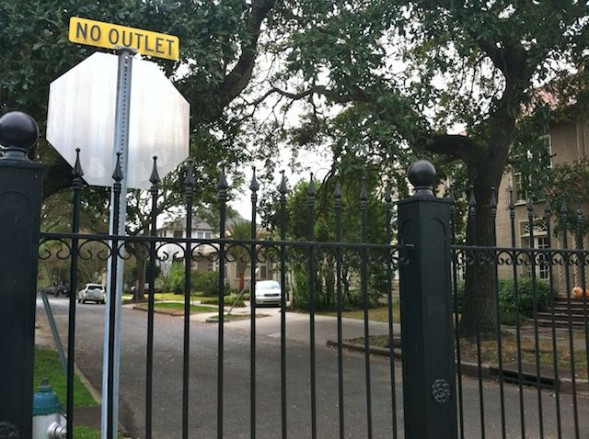
If you thought you could finally take a breath following the deluge of revelations of mismanagement under the Nagin administration, hold it for a bit longer. Here’s another raid on the public till that fell through the cracks. What’s curious is why the Landrieu administration, which has criticized and undone so many other Nagin-era deals, hasn’t seen fit to scuttle this one.
First, for purposes of comparison, a little background: In 2003, the residents of a very short street in Broadmoor, Trianon Plaza, were complaining about traffic from students at nearby Dominican High School and wanted their street closed. When the complaint got to City Hall, the Department of Public Works installed a temporary fence at one end of Trianon to measure the effect closure would have on neighboring streets.
After a study concluded the impact would be minimal, the DPW, on stationery bearing the name of John Shires as director, issued a report recommending the closure be made permanent – provided Trianon residents agreed to “purchase the public right of way and bear all future roadway and utility maintenance costs.”
After public hearings before the Planning Commission and City Council, Trianon residents were allowed to purchase their street bed for $97,000 and close the street.
Now, for the case in point: In 2005, residents of Newcomb Boulevard, a tony residential street off St. Charles Avenue near Audubon Park, were also complaining about traffic, in this instance from Tulane students. A request from Newcomb residents was forwarded to Shires by then-Councilmember Jay Batt’s office, advising the agency that the residents wanted the street permanently closed. (In politics, backs must be scratched : A campaign finance report filed by Batt on April 12, 2006, showed that 20 percent of his donations for that reporting period had come from Newcomb residents. Full disclosure: I ran the AnybodyButBatt campaign that helped elect his successor.)
On Jan. 31, 2006, which just happened to be Shires’ last day as director of Public Works, he signed a letter authorizing residents to close the street, and a privately-funded iron fence was duly installed at the Freret Street end of Newcomb Boulevard.
Unlike Trianon, however, the permit granted to Newcomb residents was not preceded by a temporary closure to determine impact. In fact, a City Hall-financed study conducted in early 2005 did not recommend closure or even list it as an option. The study found that traffic levels on Newcomb were not excessive and concluded that speeding could be dealt with by signage and speed bumps.
And unlike Trianon, which went before both the Planning Commission and the Council, no public notice or hearing preceded the Newcomb closure.
The most striking contrast with Trianon is this: Newcomb residents were not required to purchase their street bed. Newcomb is over three times longer than Trianon and in a much pricier area. If Trianon was worth $97,000, the Newcomb street bed should be valued well north of $500,000.
Needless to say, many who had used Newcomb to navigate congested university-area streets were upset. With another neighborhood resident (saxophonist Derek Huston) and two neighborhood organizations, in 2007 I filed suit against the city, arguing that the absence of the public hearings required for a street closure should render the permit void. The Nagin Law Department defended the closure, and city employees testified that they believe the DPW had the power to close the street without public hearings and Council approval.
In an application of perverse logic, city employees maintained that they could sidestep public hearings because they have the power to remove the Newcomb fence at any time, apparently contending that Newcomb’s iron fence is a mere temporary closure. One wonders why the residents of Trianon weren’t offered a similarly cost-free “temporary” closure.
The differing treatment accorded Trianon and Newcomb residents raises serious questions. So does the claim that a city employee – in this instance the head of Public Works – has power to close a public street without public notice or approval by the Planning Commission and City Council. When I brought the issue to the attention of the Council last week, Jackie Clarkson commented, “We don’t want a czar making decisions on street closures. That’s our job.”
What’s most curious is the Landrieu administration’s continued defense of the Newcomb closure. The administration has not hesitated to renegotiate or cancel other Nagin-era deals, such as the SDT, Metro, and Richard’s trash contracts and the botched contract to refurbish Armstrong Park. With the Newcomb street bed apparently worth over a half-million dollars and City Hall desperate for cash, why is the administration continuing to defend what appears to have been little more than a gift of public property to some of the wealthiest property owners in the city?
Keith Hardie is a New Orleans lawyer and community activist.

